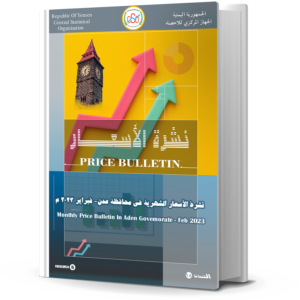Background
|
Prices considered one of the most important economic indicators in all countries, regardless of their economic and social systems. Prices used in wide and multiple areas of the national economy, such as internal and external commercial transactions, in the field of distributing economic resources between different sectors, and in building indicators that reflect changes in the prices of the standard of living, such as index numbers. It contributes to formulate a short-term and long-term economic policies, in addition to analyzing the economic reality. Prices also play a major role in the pattern and trends of international trade, and the majority of developing and developed countries alike are guided by prices and the mechanism of their changes in establishing an economic distribution of their various investments. These countries also rely on index numbers, not consumer prices, as well as the costs of living, in adjusting and determining salaries and wages, as well as determining the most important commodities that must be supported. Regarding to this importance of prices, statistical agencies in various countries of the world collect price data periodically and study the prices of various commodities traded in their local markets. Therefore, prices focus primarily on: 1- Measuring the monthly change in prices for food commodities. 2- Measuring the monthly change in prices for non-food commodities 3- Measuring the minimum cost of the basic food commodity . |
Methodology
|
Methodology The method which used in collecting prices is the sampling method because of the difficulty of collecting data for all commodities present in the markets due to their multiplicity and the cost of collecting them. Therefore, a sample closer to reality was chosen and built on the basis of equal opportunities for the markets, in addition to select the available commodities in the market and most in demand among the general citizenry, so that the commodity basket is updated according to commodity changes and their availability in the markets. The price data collection plan includes providing data related to the quantities of goods sold or produced in order to calculate weighted averages of prices and to reflect the actual price levels in the liberated governorates- in particular. In order to obtain commodity prices that represent the price impact in the markets and are used to build a number of indicators such as consumer price index or wholesale prices, as well as to rid the national income of the impact of changes, the following stages were followed: Selecting Regions Stage: A number of clusters were chosen that Reflects the differences in prices within each district. Commodity Selection Stage: The goods and commodities were classified according to the International Classification of Individual Consumption by Purpose of Use (COICOP) system according to the following categories : 1- Food and beverages category. 2-Tobacco, cigarettes and qat category. 3- Clothes and footwear category. 4- Housing and its supplies category. 5-Furniture, furnishings and household items category. 6-Transport category 7-Telecommunications category. 8- Recreational and cultural goods and services category . 9-Education Services category. 10- Services for restaurants, hotels and cafes category. 11-Health care category. 12-Various goods and services category . The collected commodities prices were chosen according to the following: A – Identifying the commodity category and selecting the sub-category within them that represent the commodities in the country so as to achieve complete comprehensiveness of the commodity categories. B – Determining the contents of each partial category comprehensively. C- Identifying the components of homogeneous commodity categories. In this step, commodity groups within one category are identified. D – Determining the specifications of goods within one category, which is one of the most important processes in collecting price data, because specifying the description of the commodity accurately helps in obtaining comparable prices in all regions within the country studied and during different periods of time , as the mechanism of studying prices requires dealing with goods of similar quality of fixed and defined specifications. Selecting data sources Stage (sampling frame): Goods were distributed to the sources through a targeted sample in which the required available goods, while ensuring geographical representation by distributing the sources of goods to all geographical locations within one directorate, while ensuring the representation of all sizes of sources within those divisions. In terms of the periodicity and pace of collecting prices, the goods were divided into groups based on the required periodicity, the pace of change in prices, and the level of variation and fluctuation from one period to another and from one place to another, so that there are: 1- Goods and commodities collected weekly from more than one source in one directorate, such as vegetables and fruits, wholesale and retail. 2- Goods and commodities are collected on a monthly basis and are more stable than the first, food items, wholesale and retail. 3- Goods are collected quarterly during the year, such as services such as clothes and shoes, electricity, water, furniture, household equipment, household hygiene tools, health (services, medical care, education supplies, and various goods and services. 4- Goods collected semi-annually, such as rents, durable household electrical appliances, etc., transportation, communications, entertainment, and culture). Restaurants and hotels. 5- Goods collected annually, such as education fees. |
The Most Important Indicators
The most important indicators are provided by the price department, which are used to build index numbers for Consumer Commodity Prices as well as Inflation according to the requirements for calculating national accounts indicators.
1-Food price indicator and expanding its coverage of prices.
2- Price indicator for services and non-food goods and expanding its coverage of prices.
3-Indicator of minimum cost average of the food commodity .
Price Bulletins
Information Bank
Statistical Tables
Average wholesale prices for 2022
The minimum cost of the food basket according to the liberated governorates for the year 2022




